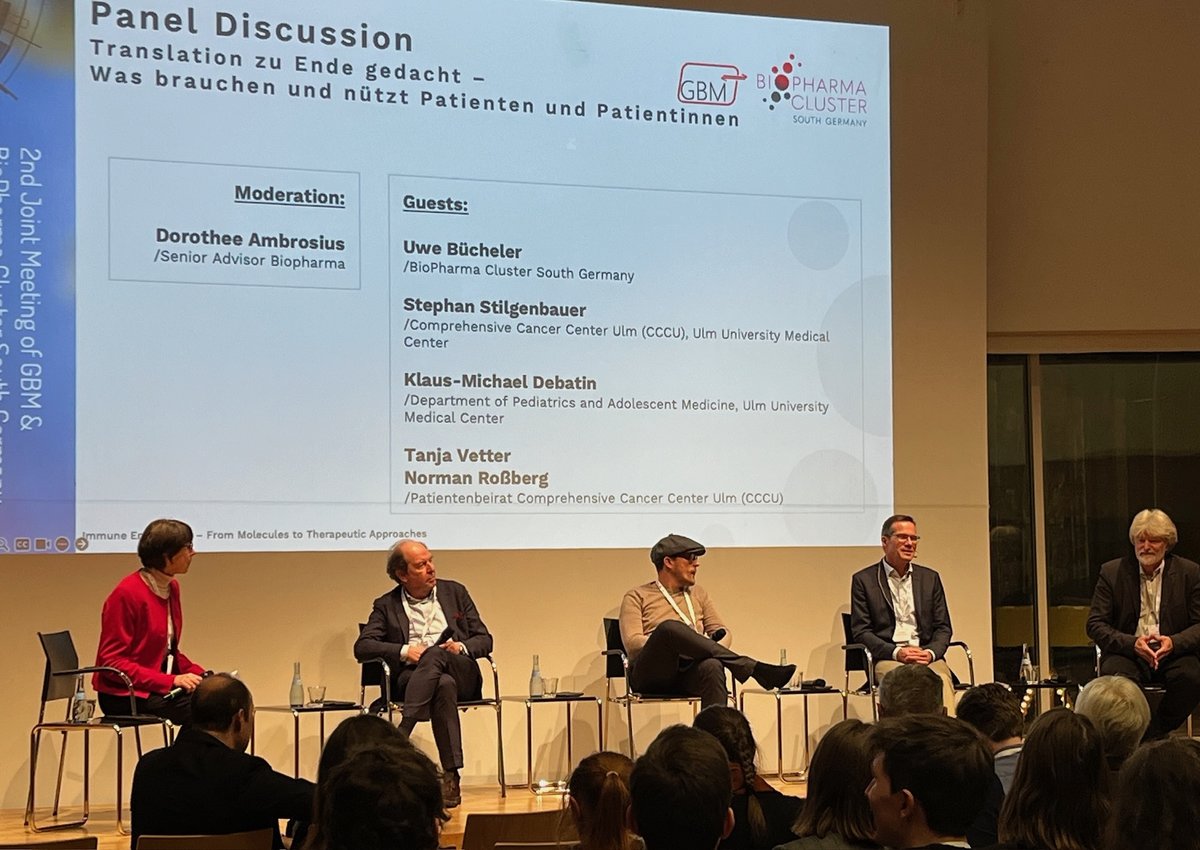Translation in Immune Engineering - Holistic view from basics to the patient’s perspective
The 2nd joint event of the BioPharma Cluster South Germany and the German Society for Biochemistry and Molecular Biology (GBM) held on 1 December in Ulm focussed on “Immune Engineering - from Molecules to Therapeutic Approaches”. This year’s topic attracted more than 130 participants from academia, industry and medicine to Ulm.

The focus on the event was on translational research in immune engineering, covering basic research, drug development and manufacturing, and clinical application. The patients' perspective has also been addressed in the panel discussion.
Immunotherapies – new promising paths
Harnessing the power of the human immune system is currently emerging to be a promising way for previously uncurable diseases. Antibodies remain the mainstay of immunotherapy and continue to offer great opportunities for the future. Engineering immune cell communication through customised cytokines or the direct editing of immune system cells as living drugs are current developments in the field.
Advanced T-Cell therapies
Matthias Feige’s lecture addressed the engineering of immune cell communication for novel therapies. The scientist from the Technical University of Munich (TUM) presented a novel immune signaling molecule developed in its laboratory for the causal treatment of sepsis. The physician Dirk Busch, also from TUM, gave an overview about adoptive T cell therapies for the treatment of infections and cancer with primary and engineered T cells. Andrea Schmidts' lecture focussed on the development of resilient chimeric antigen receptor (CAR)-T cell therapies. In her talk she presented results from a dual specificity CAR for multiple myeloma. These dual-targeting CAR T cells have potential to avoid the antigen escape that can occur with single-antigen targeting.
The long and challenging way from bench to bedside
It takes up to 15 years and about 1 billion Euros from the laboratory to the patient's bedside, outlined Uwe Bücheler, senior advisor to the biopharmaceuticals at Boehringer Ingelheim, before a new drug can be used on patients. The Biberach site, about half an hour south of Ulm, is home to the largest research and development centre within Boehringer Ingelheim’s global network and is also one of the largest sites in Europe for the production of biopharmaceuticals based on cell cultures.
Once the research has been completed and the lead molecule optimised, the development and supply of a new biopharmaceutical can begin. The development of a cell line as a production organism for a biologic substance of interest is the first step after successful research. Ann-Cathrin Leroux from Sartorius Stedim Cellca at Ulm, the cell line development unit for of global biopharma industry supplier Sartorius, outlined the steps required to generate customised cell lines from preclinical development to market supply.
Rentschler Biopharma, a global contract development and manufacturing organization (CDMO) supports its biotech and pharma clients from the early development phases through to long-term commercial market supply. AsChristiane Bardroff, COO of the company, explained, there is a challenge to win the race to market for their clients and to transfer the robust and reliable bioprocess from lab to manufacturing scale.
Jörg Zimmermann from Vetter, a global CDMO expert for drug product development, aseptic filling, assembly and packaging, provided insights into the variety of application systems for liquid and freeze-dried biopharmaceuticals. The family-owned Ravensburg-located company supports most major biotechs and pharma from early clinical development to global market supply.
Stefan Ottmar Fügenschuh from Teva Biotech Ulm, where the pharma giant's most complex site is located, presented “Genesis”. The this biotech facility, which is currently in the qualification phase, active pharmaceutical ingredients derived from mammalian cells are produced on a large scale. The Ulm site as the group's biotech centre offers the commercial manufacturing and testing of low-volume biosimilars and ,in future, the commercial manufacturing of large quantities of biosimilars and new biological active ingredients in the new facility.
When new molecules meet medical reality
Stephan Stilgenbauer, medical director of the Comprehensive Cancer Center Ulm, brought the high-flying ambitions of preclinical data down to earth by presenting current and sometimes surprising results of clinical studies of various tumour entities. Stilgenbauers’ lecture demonstrated the high volatility when biology meets targeted cancer therapy in patients. With regard to CAR-T-Cell therapies he referred to increased adverse effects (CRS or ICANS) of CAR-T-cells in comparison to bispecific antibodies. Despite previous positive results, a controlled clinical trial failed to demonstrate that early intervention with a small molecule in a subset of patients with chronic lymphocytic leukemia provides an overall survival benefit when compared to placebo.
Patients must be better involved in medical translation
In a concluding panel discussion, the different perspectives from science, industry and clinic were discussed from the patient's point of view. One of the main conclusions was that patients must be involved earlier and better in the development of innovative therapies. Their involvement in clinical trials, which suffer from too much bureaucracy in Germany, must be improved. For example, information written in English technical jargon makes it difficult for patients to participate in clinical trials. further, for cancer patients, whose primary goal is to improve and cure their serious illness, data protection and sharing play a subordinate role.
Please note and hold the date
The 3rd joint event of the BioPharma Cluster South Germany and the German Society for Biochemistry and Molecular Biology (GBM) will take place on 29th November 2024 and focus on virus-based therapeutics.
